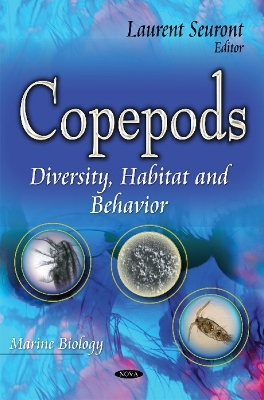
Copepods
Diversity, Habitat & Behavior
Seiten
2014
Nova Science Publishers Inc (Verlag)
978-1-63117-846-7 (ISBN)
Nova Science Publishers Inc (Verlag)
978-1-63117-846-7 (ISBN)
Copepods are among the most abundant multi-celled organisms on Earth and can literally be found everywhere there is (even not so much) water. This very diverse group of small (typically in the 1-10 mm range) crustaceans -- known for more than two millennia -- exhibit a range of free living forms, either in the open water or in various types of sediments. They are also often found as both internal and external parasites of most phyla of animals in water. Copepods also play a fundamental ecological role in the open waters of lakes, rivers, estuaries and oceans. They are the classical herbivorous link between the primary production of phytoplankton and the larvae and juveniles of fishes -- hence ultimately whales and fisheries -- in most pelagic ecosystems. In oligotrophic waters, copepods also play an essential role in transferring (i) the organic carbon released by phytoplankton (ie: up to 50% of the carbon fixed through photosynthesis) and subsequently assimilated by heterotrophic bacteria, and (ii) the inorganic carbon fixed by prokaryotic and eukaryotic picoplankton (ie: up to 70 % of the carbon fixation in oligotrophic systems) towards higher trophic levels through copepod grazing on microzooplankton (ie: heterotrophic flagellates and ciliated protozoans).
Pelagic Diversity & Climate Change; Community Ecology of Pelagic Copepods in Tropical Coastal Waters; Harpacticoida (Copepoda) under Hypoxia Conditions in the Black Sea; Antarctic Lacustrine Copepods: Scattered Remnants of an Ancient Fauna & Recent Marine Invaders; Marine Copepods & Solar Radiation; Swimming, Feeding & Mating Behavior in Copepods: A Brief Review; High-Speed Imaging in Copepod Behavior; The Sensory Horizon of Marine Copepods; Nano- & Microfluidics, Rheology, Exopolymeric Substances & Fluid Dynamics in Calanoid Copepods; Copepod Behavior: Oceanographic Cues, Distributions & Trophic Interactions; Copepod Carcasses: Occurrence, Fate & Ecological Importance.
| Verlagsort | New York |
|---|---|
| Sprache | englisch |
| Maße | 180 x 260 mm |
| Gewicht | 744 g |
| Themenwelt | Naturwissenschaften ► Biologie ► Limnologie / Meeresbiologie |
| ISBN-10 | 1-63117-846-6 / 1631178466 |
| ISBN-13 | 978-1-63117-846-7 / 9781631178467 |
| Zustand | Neuware |
| Haben Sie eine Frage zum Produkt? |
Mehr entdecken
aus dem Bereich
aus dem Bereich
Naturerfahrungen zwischen Quelle, See und Wildfluss
Buch | Hardcover (2024)
Verlag Anton Pustet Salzburg
30,00 €
Buch | Hardcover (2022)
National Geographic Deutschland (Verlag)
39,99 €


